
The eagle rays are a group of cartilaginous fishes in the family Myliobatidae, consisting mostly of large species living in the open ocean rather than on the sea bottom.

A sawshark or saw shark is a member of a shark order bearing a unique long, saw-like rostrum edged with sharp teeth, which they use to slash and disable their prey. There are eight species within the Pristiophoriformes, including the longnose or common sawshark, shortnose sawshark, Japanese sawshark, Bahamas sawshark, sixgill sawshark, African dwarf sawshark, Lana's sawshark and the tropical sawshark.

The bat ray is an eagle ray found in muddy or sandy sloughs, estuaries and bays, kelp beds and rocky-bottomed shoreline in the eastern Pacific Ocean, between the Oregon coast and the Gulf of California. It is also found in the area around the Galápagos Islands. The largest specimens can grow to a wingspan of 1.8 m and a mass of 91 kg (201 lb). They more typically range from 9.07–13.61 kg (20.0–30.0 lb). The size of the bat ray is dependent on many factors, such as habitat alterations, different oceanographic and environmental conditions. Bat rays have one to three venomous barbed spines at the base of its tail. Some bat rays are solitary while others form schools numbering in the thousands.

The dark ghostshark is a shortnose chimaera of the family Chimaeridae, found on the continental shelf around the South Island of New Zealand. In June 2018 the New Zealand Department of Conservation classified the dark ghostshark as "Not Threatened" under the New Zealand Threat Classification System.

Myliobatis is a genus of eagle rays in the family Myliobatidae.

The New Zealand eagle ray or Australian eagle ray is an eagle ray of the family Myliobatidae, found in bays, estuaries, and near rocky reefs around New Zealand and southern Australia on the inner continental shelf. It is a common species and the International Union for Conservation of Nature has assessed its conservation status as being of "least concern".

The shortnose sawshark, or southern sawshark, is a sawshark of the family Pristiophoridae. The body of this shark is slightly compressed, and its rostrum is narrow. The two dorsal fins are almost identical in size. In color, the dorsal side of this sawshark tends to be uniformly slate gray, with few or no markings. The ventral side is pale white or cream. Females reach around 124 cm (49 in) long, and males reach around 110 cm (43 in) long. These sharks can live up to 9 years.

The shortnose spurdog also known as the piked spurdog is a small shark located primarily off the coast of Southern Australia and South Africa. The shortnose spurdog's size is dependent on the sex of the animal. The female shortnose spurdog is consistently larger than the male shortnose spurdog and will typically measure out to about 56.41 cm (1.85 ft) while the male shortnose spurdog will typically only measure out to about 44.36 cm in length (1.46 ft) which means the female shortnose spurdog is over 10 cm longer than the male shortnose spurdog. Some females can even measure up to 78 cm which is over 2.5 feet long. The life span of spurdog's can be quite long with females typically living longer than males. The average life span of a female shortnose spurdog is 0–29 years old while the male life span is 0-26 though it is estimated that a female can live up to 46 years while a male can only live up to 33. Females also take longer to reach sexual maturity than males and on average are not fertile until they are over 15 years of age. 7 years longer than the 8 years it takes males to reach maturity. The shortnose spurdog's eat a variety of items but primarily favor cephalopods such as squid and octopuses for their meals. Other organisms that have been found in their stomachs include fish, hermit crabs, sponges, brittle stars, the remains of sea lion and even primary producers such as algae.
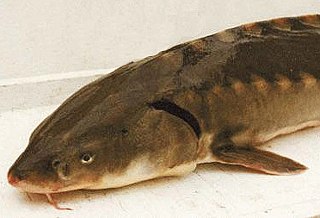
The shortnose sturgeon is a small and endangered species of North American sturgeon. The earliest remains of the species are from the Late Cretaceous Period, over 70 million years ago. Shortnose sturgeons are long-lived and slow to sexually mature. Most sturgeons are anadromous bottom-feeders, which means they migrate upstream to spawn but spend most of their lives feeding in rivers, deltas and estuaries. The shortnose sturgeon is often mistaken as a juvenile Atlantic sturgeon because of its small size. Prior to 1973, U.S. commercial fishing records did not differentiate between the two species: both were reported as "common sturgeon", although it is believed based on sizes that the bulk of the catch was Atlantic sturgeon. The shortnose is distinguishable from the Atlantic sturgeon due to its shorter and rounder head.
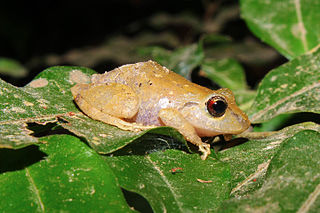
Pristimantis ridens, also known as the pygmy rain frog and the Rio San Juan robber frog, is a species of frog in the family Strabomantidae. It is found in western Colombia, and then through Panama and Costa Rica to Nicaragua and eastern Honduras.

The Chilean eagle ray is a species of fish in the family Myliobatidae. Found off the coasts of Chile and Peru, its natural habitat is open sea.

The purple eagle ray is a species of fish in the family Myliobatidae. It was formerly considered endemic to Australia but is now known to be more widespread. Its natural habitat is the open seas where it has a patchy distribution, and the International Union for Conservation of Nature has assessed its conservation status as being "near-threatened".
The longnose eagle ray or snouted eagle ray is a species of fish in the family Myliobatidae. It is found in the East Pacific Ocean from Baja California and the Gulf of California to Sechura, Peru, ranging from shallow water to a depth of 64 m (210 ft). This species was first described in 1964 by the American ichthyologist Shelton Pleasants Applegate, who was an expert on fossil and living sharks, and by American marine biologist John Edgar Fitch.

The Peruvian eagle ray is a species of fish in the family Myliobatidae. It is found in the Pacific Ocean off Chile and Peru. It can be differentiated from the similar Chilean eagle ray by color and rostral fin form. The ray has not been extensively studied, and is ranked as Data Deficient by the IUCN. It has been recorded only in the open ocean, but is considered likely to be a benthic feeder. It is thought by scientists to be similar to other myliobatids in terms of biology, habits, and threats.
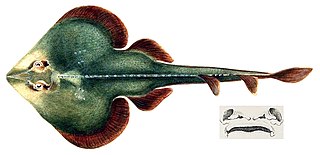
The shortnose guitarfish is a species of fish in the Trygonorrhinidae family found in the southwest Atlantic in coastal parts near sandy sea floors of southern Brazil, through Uruguay, to northeast Argentina. It reaches a length of 66 cm (2.17 ft). Their diet consist of Crabs, worms, clams and small fishes. The guitarfish has become critically endangered because of the rapid decline caused by overfishing.
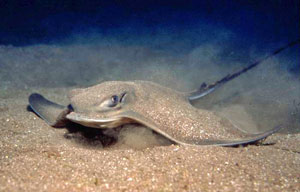
The common eagle ray or bullray is a species of fish in the family Myliobatidae. It inhabits the eastern Atlantic Ocean, the Mediterranean Sea and the south-western Indian Ocean.

The bullnose ray is an eagle ray, which is widely distributed in the western Atlantic. It is found at depth above 10 m (33 ft) in coastal waters from Cape Cod down to Argentina, but is absent from parts of the western central Atlantic. It reaches a maximum size of 106 cm (42 in) in disc width and gives birth to six young per litter. It is often confused with the southern eagle ray. The bullnose ray feeds mostly hermit crabs, gastropods, and bivalves.
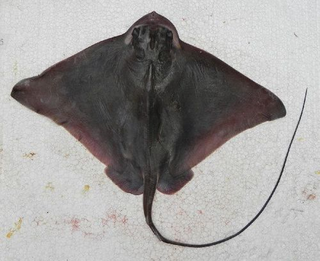
The Southern eagle ray, sometimes known as the Southern eagle fish or the rockfish, is a ray species in the family Myliobatidae. It lives in waters just off of the Atlantic coast, from the tip of Florida down to Argentina, inhabiting estuaries or bays to give birth during spring and summer and migrating to the open sea in autumn and winter. It has an average width of 99 centimeters, and a length of 60 centimeters. It is often confused with the bullnose ray, a related species in the genus Myliobatis, due to the two species' similarities in appearance.
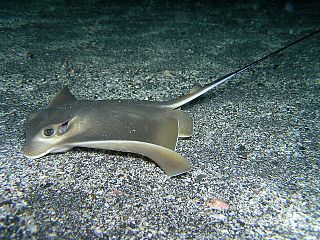
The Japanese eagle ray, also known as the cowhead eagle ray or kite ray is a ray species in the family Myliobatidae.
















